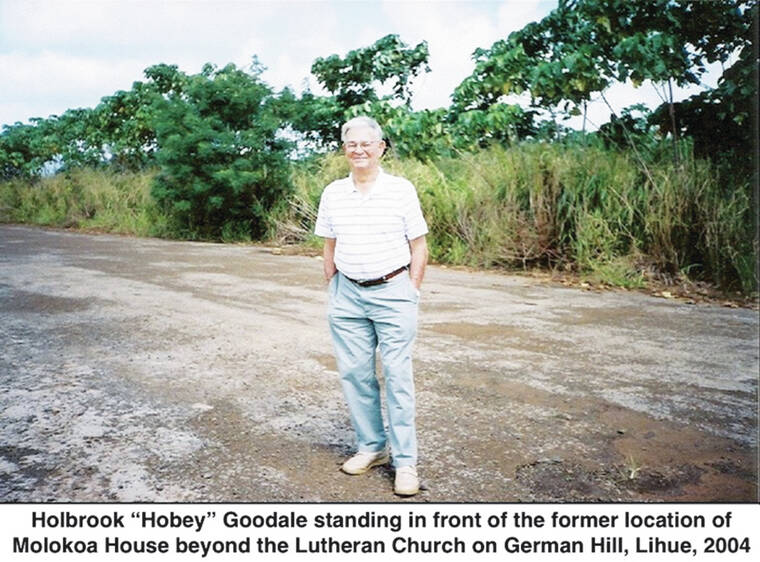Holbrook “Hobey” Goodale (1923-2014) of Kaua‘i was a descendant of American Protestant missionaries to Hawai‘i William Harrison Rice and Mary Sophia Hyde Rice. His great-grandfather, William Hyde Rice, had been Kaua‘i’s governor under Queen Lili‘uokalani. Charles Rice, his grandfather, owned Kipu Sugar Plantation and Kipu Ranch, and his mother, Juliet Rice Wichman, founded the Kaua‘i Museum.
He himself was a World War II veteran, had been the Kipu Ranch foreman, was the proprietor of Kaua‘i’s Ford dealership for 40 years, and had married Nancy Sloggett, also a missionary descendant.
I’d gotten to know him personally while writing a column for The Garden Island newspaper during the early 2000s, titled “History Makers of Kaua‘i.”
One day in 2004, he invited me to visit several historic places with him in his truck.
At Kalapaki, he said that on the night of Dec. 30, 1941, during World War II, a Japanese submarine had shelled Nawiliwili Harbor.
During the attack, he and grandfather Rice had observed the attack from Rice’s Kalapaki home, now the site of the Royal Sonesta Kaua‘i Resort’s pool.
Next, we went to the former location of Molokoa House beyond the Lutheran Church on German Hill.
Demolished in the 1970s, it had been the home of the Rev. Hans Isenberg and his wife, Mary Dorothea Rice Isenberg, during the late 1800s to early 1900s.
In the old days, plantation kids would stop by Molokoa House at Christmastime to be given brown paper bags filled with oranges, apples and Christmas candies by the Isenbergs.
Then we visited Koamalu on Uahi Road, where the missionary Rices had resided in a teak, wood-paneled house for several years following their arrival on Kaua‘i in 1854.
Their homesite is now occupied by the old Lihu‘e Plantation manager’s house.
We then set off for Hule‘ia, once the locale of the Hule‘ia Camp of Charles Rice’s Kipu Sugar Plantation (1907-1942), only sparsely settled today.
Lastly, we stopped at Malumalu on Hulemalu Road.
Now uninhabited, it was the abode of four married couples — the Hardys, Bonds, Reynoldses and Marshalls — during the early-1850s, and the site of Malumalu School from 1890 to 1898.
•••
Hank Soboleski has been a resident of Kauai since the 1960s. Hank’s love of the island and its history has inspired him, in conjunction with The Garden Island Newspaper, to share the island’s history weekly. The collection of these articles can be found here: https://bit.ly/2IfbxL9 and here https://bit.ly/2STw9gi Hank can be reached at hssgms@gmail.com




Hank Soboleski, mahalo for the story. Hobey was a personal and family friend. Brings back a lot of memories of Kipu and Kauai. And, Lihue little league.
I am interested in information regarding immigrant settlement around 1910 in the Kipu/Huleia area. There used to be a hill the locals called Cherry Rice hill. There was a cemetery there where each grave was in a tiny house like structure. I presume that was to protect the graves from destruction by peacocks. In the 1950s residents were asked to remove the remains. Was the property sold? Did Mr. Rice own the property?
People worked on the mountain. What sort of work did they do? What comes to mind is gathering rocks to get them crushed at the stone crusher at Halfway Bridge. That was very hard work for a woman to do, particularly a mother with a new born baby.
I would appreciate any information you can give me.
Thank you very much.
Amy Siemens